Floating Montana
5 Favorite River Floats
"I am a kayaker.
Deep in my cells I love to feel my body moving over water following the currents, absorbing the ever changing scenery along the banks, and feeling the anticipation for what is around the next bend in the river. As my kayak floats along so close to the surface of the water, I sometimes reflect on how being with the river is a metaphor for being in life.
On the river, there is no past. There is only the present moment. There is no time to dwell on what was, what could have been, or what should have been. On the river, the currents pull you forward and there you are moving downstream emotionally stripped clean. When I kayak I am able to flow harmoniously with nature’s forces and currents adapting spontaneously to the immediate need. It creates an electric excitement."
Floating a river is great recreational fun. Here are 5 great floats that, mid-summer, are suitable for most skill levels and water craft. Three are big rivers, and two are small. They may, depending on flow rate, be a little long for rafts and drift boats, so be sure to check with local sources of information regarding estimating floating times.
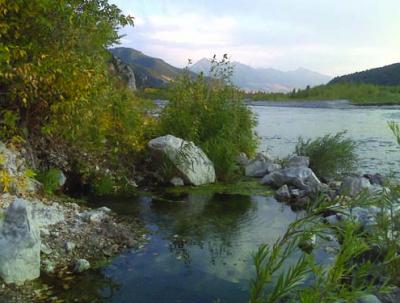
Yellowstone River
The Yellowstone is big, long, wild, and loaded with history. With 550 floatable river miles, one of my favorite segments is Columbus to Laurel. A good portion of this stretch, primarily the bottom half, is away from the asphalt and railroad tracks. As a result, it’s quieter and fairly pristine. With a natural flood corridor, there are islands and secondary channels.
Put in at Columbus Itch-Kep-Pe Park and take out at either Buffalo Mirage Fishing Access Site (FAS) or Laurel Riverside Park, which are either 23 or 29 miles respectively. There is good camping at Itch-Kep-Pe, Buffalo Mirage. This is a long stretch, but if you have a good flow rate and craft you can do it in a day.
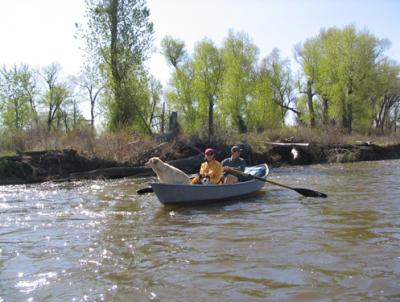
Jefferson River
The Jefferson is relatively small and intimate. In the spring, at high flow, there are lots of sloughs and side channels to explore. Much of the river is not near roads, braids nicely, and has excellent wildlife habitat. As long as the flow rate is above 3,000 cfs, any vessel is suitable from Sappington Bridge FAS to Drouillard FAS (15 miles). At higher flows, or with a good paddle craft, you may consider going all the way to Missouri Headwaters State Park (24 miles). There are some small bridges, most are no problem, but the old railroad bridge above “Headwaters” has folded more than a few canoes at high flows.
It’s always been my feeling that the “Jeff” comes the closest to providing an environmental experience akin to what the members of the Lewis and Clark expedition experienced as they followed the course of our Montana rivers. The close proximity of birds and wildlife, dense willows and cottonwoods, and long reaches with no visible buildings contribute to a feeling of wild serenity.
The Jefferson does get dewatered by irrigators in the second half of the summer and may get very low in drought years, so go early (and often).
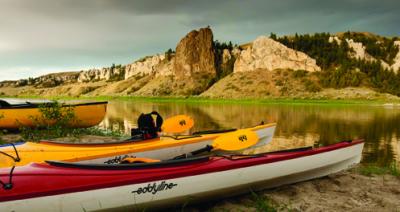
Missouri River
Many people in America know the Missouri River, and it’s the same here in Montana. Up and downstream of Cascade is an easy day trip for beginners with legendary fishing and spectacular “white cliffs” and “breaks.” To get a taste, consider paddling from Fort Benton (great boat ramps right in town) to Loma (Loma Bridge FAS, 22 miles downstream).
You float by a prairie landscape with steep-sided grassland bluffs, which are incised by coulees and draws that are frequented by mule deer, coyotes, and eagles. The water is fundamentally flat and easy to navigate, but wind is common and is a potential hazard for the unwary. Whitecaps and gusts may threaten stability or impede progress.
This stretch of the Missouri is a fine introduction to the Mighty Mo,’ which just might inspire you to tackle the weeklong trip downstream.
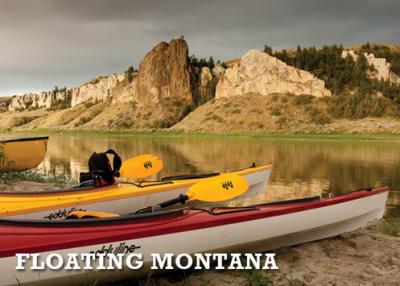
Flathead River
The forks and tributaries of the Flathead River provide numerous options, but for an incredible balance of shoreline picnic sites, scenery, convenience of access, ease of shuttle, and quality habitat it’s hard to beat a float from Teakettle FAS to the Old Steel Bridge FAS (15 miles). And it’s all happening between Columbia Falls and downtown Kalispell.
Multiple channels and backwaters provide a diversity of paddling options, making it a great place to recreate and hone your basic paddling skills. The diversity of channels and abundance of shoreline create excellent habitat, particularly for birds, but also for floaters.
One note: the possibility of increased flow from Hungry Horse Dam located upstream on the South fork. This may significantly change the river flow rate. Typically these will be publicly announced, but be sure to pay attention and check flow rates.
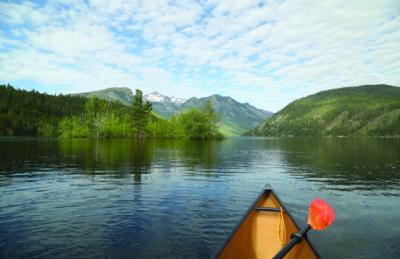
Bitterroot River
The Bitterroot River Valley in western Montana is spectacular, and floating a river is the best way to experience it. To paddle the section from Victor (Bell Crossing FAS) to Florence (Florence Bridge FAS) is a magnificent 15-mile float. Big scenery, a great braided and frequently flooded channel, and proximity to the Lee Metcalf Wildlife Refuge make this particular segment naturally attractive.
This is a smaller, but winding river, so be prepared to backpaddle to contend with possible flood debris and sudden turns.
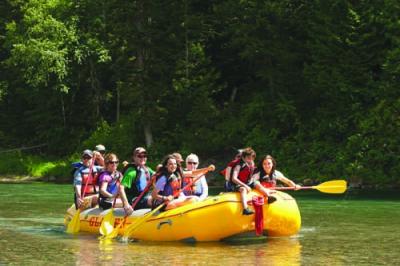
SAFETY FIRST
HAZARDS
Know your skill level. Water itself is a hazard, but moving water even more so. You must know how to maneuver your boat, where to go, and what to avoid. Practice on slow and flat water, possibly a nearby lake or pond, then cautiously move up to a current. Many retail gear shops, clubs and organizations, and universities will have classes in which you can learn from experienced folks.
Multiple braided channels. Keep your party visible at all times.
Scout your put-in and take-out sites. Know your beginning and ending landmarks. Spring and early summer can be the most hazardous times due to melting snow and spring rain. Cold and high water, sudden changes in weather, large waves, floating debris, strong and fast currents can all be very dangerous. If you are a beginner, consider going mid-to-late summer and with experienced people.
Obstacles—flood debris, down trees, logjams, bridge abutments, fence materials, emergent or submerged rocks and boulders.
Always take
(this is a partial list, so consider where you are going): Once you put on the river, you are committed, so be prepared.
- Personal Flotation Device (PFD) for each person (must be worn by children 12 years old and under).
- First aid kit
- Spare paddle/oar
- Rain suit/dry clothes/stable river footwear
- Brimmed hat
- Sunscreen/sunglasses/lip balm
- Survival kit – fire starter, noisemaker (whistle), “space blanket,” cloth tape, knife
- River maps/pencil and paper to collect your own notes for future reference
- Adequate food/water
- Dry storage bags or boxes
BEFORE YOU GO
Check some easy sources of information
U. S. Geologic Survey Real Time Data for Montana Streamflow
www.waterdata.usgs.gov/mt/nwis/current?type=flow—provides information regarding the amount of water in the river and can indicate the flood stages of the waterway. Start thinking in terms of “cubic feet per second” (cfs) and document your travel times, safety issues, obstacles, and experiences based on that flow.
Google Earth can be an easy way to view the put in and take out points and can give you a rough idea of obstacles and channel variation at the time of the image.
Montana Fish Wildlife and Parks—Our State agency which manages many of our Fishing Access Sites (FAS) has information on-line and in publications.
ADDITIONAL INFORMATION
Books:
- Paddling Montana by Hank and Carol Fischer
- Floating Montana by Curt Thompson
Maps:
- Montana Afloat maps
- River Rat maps
People are one of your best resources. Retailers, fishing shops, rafting companies and shuttle providers are all good sources of information.

TYPE OF BOAT
Kayak: Closer to the water, good for waves, usually more maneuverable, carries less gear, come in a variety of styles, generally a one person craft requiring technique and skill. Can be designed for whitewater or flat water.
Canoe: One to two people, can carry quite a bit of gear, fairly maneuverable, requires technique and skill, but, in most cases, does not handle large waves well.
Raft: Very forgiving vessel, can carry gear and multiple people, a rowing frame helps a lot. Rafts handle whitewater and waves well. They do not handle wind well.
Drift Boat: Very comfortable, usually handle whitewater reasonably well, easily maneuverable with practice, good for carrying gear.
ETHICS AND STEWARDSHIP
Be aware of the rules and regulations relating to using Montana waters. Become familiar with Montana’s Stream Access Law.
Be considerate of other floaters, landowners and fisherman. The Montana Fish Wildlife and Parks Web site has good information.
If you use the resource, consider how you can help maintain it. Our rivers are some of our most valuable natural resources. Yet they are in constant need of protection. Learn about the issues affecting your local waterways, the organizations working to protect them, and consider joining the effort.






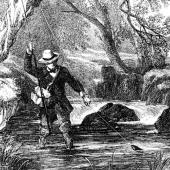





Leave a Comment Here